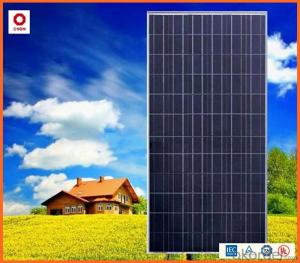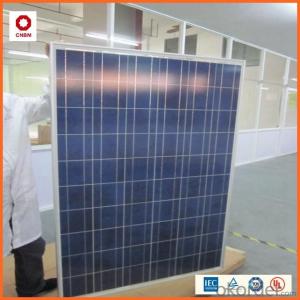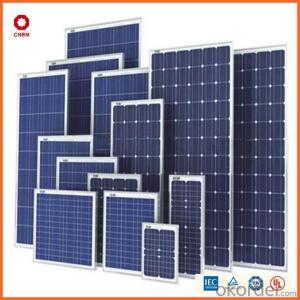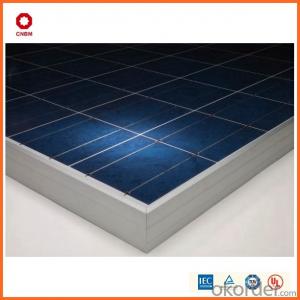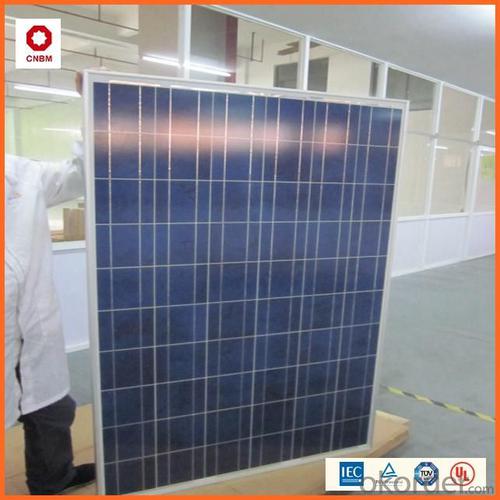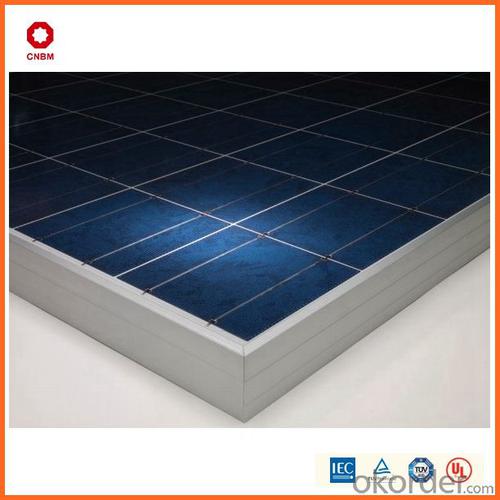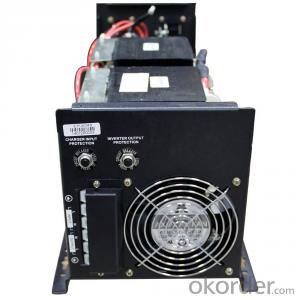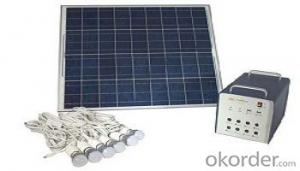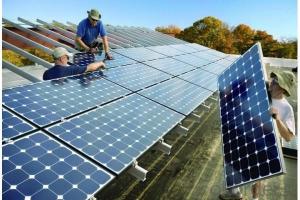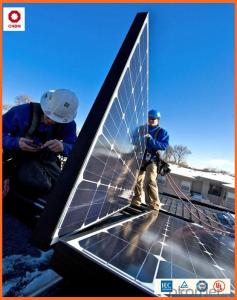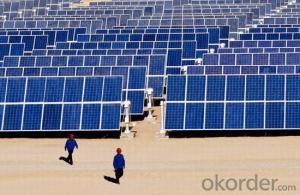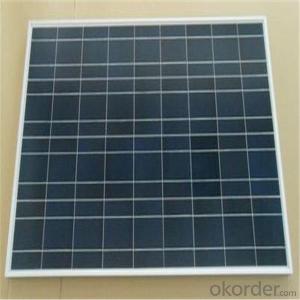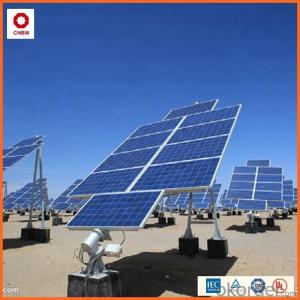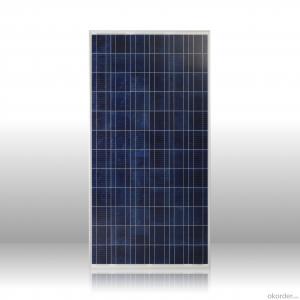Quality Solar Energy Systems - 300W Poly Solar Panel 0.46/W A Grade Good Quality
- Loading Port:
- China main port
- Payment Terms:
- TT OR LC
- Min Order Qty:
- 1 watt
- Supply Capability:
- 10000000 watt/month
OKorder Service Pledge
OKorder Financial Service
You Might Also Like
Product Description:
Hot Sale !!! Quality and Safety of 245w-320w Poly Solar Panel
1. Rigorous quality control meets the highest international standards.
2. High-transmissivity low-iron tempered glass, strong aluminium frame.
3. Using UV-resistant silicon.
4. IS09001/14001/CE/TUV/UL
Warranties of 245w-320w Poly Solar Panel
1. 10 years limited product warranty
2. 15 years at 90% of the minimal rated power output
3. 25 years at 80% of the minimal rated power output
Technical date of 245w-320w Poly Solar Panel
ITEM NO.: | Mono 125*125 cell ,36pcs . Power range from 80Wp-100Wp | ||||||||
Maximum Power(W) | 80 | 85 | 90 | 95 | 100 | ||||
Optimum Power Voltage(Vmp) | 17.81 | 17.89 | 17.94 | 17.99 | 18.06 | ||||
Optimum Operatige Current(Imp) | 4.78 | 4.91 | 5.12 | 5.35 | 5.59 | ||||
Open Circuit Voltage(Voc) | 21.98 | 22.05 | 22.14 | 22.28 | 22.45 | ||||
Short Circuit Current(Isc) | 4.95 | 5.15 | 5.36 | 5.65 | 5.84 | ||||
Solar Cell: | 125*125 Mono | ||||||||
Number of Cell(pcs) | 4*9 | ||||||||
Brand Name of Solar Cells | JA Cell, Bluesun Cell | ||||||||
Size of Module(mm) | 1580*808*35 | ||||||||
Caple & Connector Type | Pass the TUV Certificate | ||||||||
Frame(Material Corners,etc.) | Aluminium-alloy | ||||||||
Backing (Brand Type) | TPT | ||||||||
Cell Efficiency for 100W(%) | 15.8% | ||||||||
Weight Per Piece(KG) | 12.0KG | ||||||||
FF (%) | 70-76% | ||||||||
Junction Box Type | Pass the TUV Certificate | ||||||||
Tolerance Wattage(e.g.+/-5%) | ±3%, or 0-3% | ||||||||
Front Glass Thikness(mm) | 3.2 | ||||||||
Temperature Coefficients of Isc(%) | +0.04 | ||||||||
Temperature Coefficients of Voc(%) | -0.38 | ||||||||
Temperature Coefficients of Pm(%) | -0.47 | ||||||||
Temperature Coefficients of Im(%) | +0.04 | ||||||||
Temperature Coefficients of Vm(%) | -0.38 | ||||||||
Temperature Range | -40°C to +85°C | ||||||||
Surface Maximum Load Capacity | 2400Pa | ||||||||
Allowable Hail Load | 23m/s ,7.53g | ||||||||
Bypass Diode Rating(A) | 12 | ||||||||
Warranty | 90% of 10 years,80% of 25 years. | ||||||||
Standard Test Conditions | AM1.5 1000W/ 25 +/-2°C | ||||||||
Packing | carton or pallet | ||||||||
1*20' | 25 Pallets / 450pcs | ||||||||
1*40'STD | 25 Pallets / 100pcs | ||||||||
Features of our products:
• High conversion efficiency mono/poly-crystalline amorphous silicon solar cells
• Modules incorporate high performance bypass diodes to minimize the power drop caused by shading
• High transmittance, low-iron tempered glass
• High performance EVA encapsulant to prevent destroying and water.
• AI frame: without screw, corner connection. 8 holes on the frame can be installed easily
• Good performance of preventing from atrocious weather such as wind and hails
• Certifications: CE IEC TUV VDE UL, Class I
• 10 years 90% power output warranty
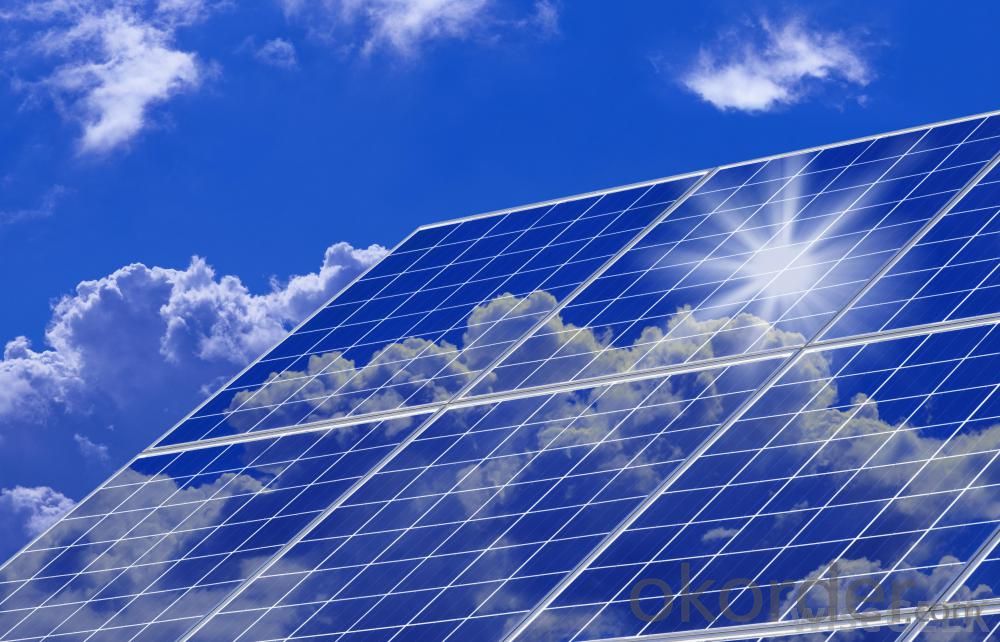
Shipping of 245w-320w Poly Solar Panel
By Sea | Delivery from Shanghai or Ningbo seaport |
By Air | Departure from Shanghai Pudong Airport |
By Express | Post by DHL, EMS, UPS, TNT. |
- Q: How do solar energy systems impact energy storage technologies?
- Solar energy systems have a significant impact on energy storage technologies by providing a clean and renewable source of electricity. These systems generate electricity during the day when the sun is shining, but often produce more energy than needed. Energy storage technologies allow excess energy to be stored and used during periods of low or no solar generation, ensuring a constant and reliable power supply. This integration of solar energy systems with energy storage technologies promotes grid stability, reduces reliance on fossil fuels, and accelerates the transition towards a sustainable energy future.
- Q: Can solar energy systems be used to power an entire household?
- Yes, solar energy systems can be used to power an entire household. With sufficient solar panels and a properly sized battery storage system, a solar energy system can generate enough electricity to meet the energy needs of a household. Additionally, excess energy produced during the day can be stored in batteries and used during nighttime or cloudy days, ensuring a continuous power supply.
- Q: How do solar energy systems impact local wildlife?
- Solar energy systems have a minimal impact on local wildlife. While there may be initial disturbances during construction, once operational, solar panels do not produce harmful emissions or noise, reducing their impact on both terrestrial and aquatic species. Furthermore, solar farms can provide habitat for certain species, such as pollinators, and their installation can be designed to minimize any potential negative effects on wildlife.
- Q: Do solar energy systems require surge protection?
- Indeed, surge protection becomes imperative when it comes to solar energy systems. The susceptibility of these systems to power surges caused by lightning strikes, grid fluctuations, or other electrical disturbances necessitates the presence of surge protection. The fragile electronic components of a solar energy system, like inverters or charge controllers, can be severely compromised or even annihilated by power surges. Hence, the deployment of surge protection devices, such as surge protectors or surge arresters, is crucial in diverting excessive voltage away from the system, thereby safeguarding it from harm and ensuring its durability. Furthermore, the inclusion of surge protection is often mandated by electrical codes and regulations to guarantee the safety and dependability of solar energy systems.
- Q: Are there any ongoing monitoring requirements for solar energy systems?
- Solar energy systems have ongoing monitoring requirements to ensure efficient and effective operation. Monitoring is crucial for identifying and addressing any potential issues or malfunctions promptly. Ongoing monitoring involves tracking various aspects of the system's performance, such as energy production, system uptime, and deviations from expected outputs. This can be accomplished using different monitoring tools and technologies, including real-time monitoring software, data loggers, or remote monitoring systems. Furthermore, specific monitoring requirements may exist in certain jurisdictions or incentive programs to ensure compliance with regulations or eligibility criteria. Regular monitoring is essential for maximizing the benefits of solar energy systems and ensuring their long-term performance and durability.
- Q: How do solar energy systems impact the resale value of a commercial building?
- A commercial building's resale value can be positively influenced by solar energy systems, as several factors contribute to this increase. To begin with, solar energy systems present the building owner with potential energy savings. By harnessing electricity from the sun, the building can decrease its reliance on conventional energy sources, resulting in reduced utility bills. This cost savings can be an appealing selling point for potential buyers, as it not only lowers operational expenses but also offers a more sustainable and environmentally friendly solution. Additionally, solar energy systems are regarded as a long-term investment. They typically come with warranties and have a lifespan of 25 to 30 years or more. This means that a commercial building equipped with a solar system can provide a dependable and consistent source of renewable energy for many years to come. Buyers are often attracted to this added value, as it instills a sense of security and minimizes future energy costs. Moreover, the installation of solar energy systems showcases the building owner's dedication to sustainability and environmental responsibility. In today's market, there is an increasing demand for eco-friendly buildings and businesses that prioritize renewable energy sources. This can entice buyers who share the same values and are willing to pay a premium for a building that aligns with their sustainability objectives. Lastly, the presence of a solar energy system can enhance the overall marketability of a commercial building. With growing awareness and interest in renewable energy, potential buyers may actively seek out properties with solar installations. This heightened demand can lead to a competitive bidding process, potentially driving up the resale value of the building. It is important to acknowledge that the impact of solar energy systems on a commercial building's resale value can vary based on factors such as location, size, and system efficiency. Additionally, market conditions and buyer preferences also play a role. However, overall, solar energy systems have the potential to positively influence a commercial building's resale value by reducing energy costs, providing long-term benefits, attracting sustainability-focused buyers, and enhancing marketability.
- Q: Can solar energy systems be used for powering electric vehicle autonomous driving systems?
- Yes, solar energy systems can be used for powering electric vehicle autonomous driving systems. Solar panels can be installed on the roof of the vehicle to capture sunlight and convert it into electricity. This electricity can then be used to power the autonomous driving systems, including the sensors, cameras, and computer systems that enable the vehicle to navigate and make decisions on its own. By utilizing solar energy, the vehicle can reduce its reliance on fossil fuels and operate with reduced carbon emissions. However, it's important to note that the amount of power generated by solar panels may not be sufficient to solely power the entire autonomous driving system, especially during extended or cloudy periods. In such cases, the vehicle may still need to rely on grid charging or other charging methods.
- Q: Can solar energy systems be used in areas with high winds?
- Yes, solar energy systems can be used in areas with high winds. While strong winds can affect the efficiency of solar panels by increasing dust and debris accumulation, proper installation techniques can ensure that the panels are securely mounted. Additionally, advancements in solar panel technology have made them more durable and resistant to wind damage. Overall, with appropriate design and maintenance, solar energy systems can effectively operate in areas with high winds.
- Q: Can solar energy systems be used for commercial or industrial purposes?
- Yes, solar energy systems can definitely be used for commercial or industrial purposes. In fact, many businesses and industries are increasingly adopting solar power as a sustainable and cost-effective energy solution. Solar panels can be installed on rooftops or open spaces of commercial buildings and industrial facilities to generate clean electricity, helping to reduce reliance on traditional fossil fuels and lower energy costs in the long run. Additionally, solar energy systems can also provide a reliable and uninterrupted power supply, making them an attractive option for businesses and industries looking to enhance their sustainability efforts and achieve energy independence.
- Q: Can a solar energy system be used to charge electric vehicles?
- It is indeed possible to utilize a solar energy system for the purpose of charging electric vehicles. The sun's rays are harnessed by solar panels, also referred to as photovoltaic (PV) panels, to generate electricity. This electricity can then be employed to charge the batteries of electric vehicles. The PV panels capture sunlight and convert it into direct current (DC) electricity. Subsequently, an inverter is used to transform this DC electricity into alternating current (AC) electricity, which aligns with the charging requirements of electric vehicles. By establishing a link between the solar energy system and an electric vehicle charging station, the solar-generated electricity can directly charge the vehicle's battery. This renewable energy source not only diminishes the dependence on fossil fuels but also aids in reducing the emission of greenhouse gases associated with transportation. Moreover, any surplus electricity generated by the solar panel system during daylight hours can be stored in batteries or returned to the grid for future use, guaranteeing a continuous and sustainable power supply for charging electric vehicles.
Send your message to us
Quality Solar Energy Systems - 300W Poly Solar Panel 0.46/W A Grade Good Quality
- Loading Port:
- China main port
- Payment Terms:
- TT OR LC
- Min Order Qty:
- 1 watt
- Supply Capability:
- 10000000 watt/month
OKorder Service Pledge
OKorder Financial Service
Similar products
Hot products
Hot Searches
Related keywords
